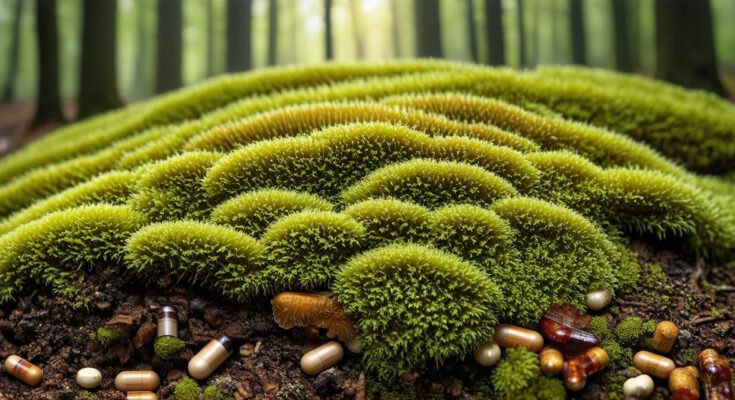Cryptogams and Reproduction
Cryptogams are non-vascular plants that are characterized by their lack of specialized tissue for the transport of water and nutrients. These plants reproduce asexually through vegetative propagation, which involves the formation of new plants from a single parent plant.
Vegetative Propagation in Cryptogams
Vegetative propagation is a process by which asexual reproduction occurs through the formation of new plants from a single parent plant. This process involves the division of the parent plant’s tissues, resulting in the formation of new plants with identical genetic material to the parent plant.
There are several methods of vegetative propagation in cryptogams, including:
- Spore Formation
- Aerial Propagation
- Rhizomous Propagation
Spore Formation
Many cryptogams reproduce through spore formation, which involves the development of specialized structures called sporangia that contain spores. These spores can be released into the environment and germinate to form new plants.
Aerial Propagation
Aerial propagation occurs when fragments of the parent plant break off and grow into new plants. This method is commonly used in horticulture to propagate certain types of cryptogams, such as mosses and lichens.
Rhizomous Propagation
Rhizomous propagation involves the growth of underground runners or stems that develop roots and shoots at each node, resulting in the formation of new plants. This method is commonly used in the cultivation of certain types of cryptogams, such as ferns and horsetails.
Comparing Cryptogam Reproduction to Other Plant Reproduction Methods
While cryptogams reproduce asexually through vegetative propagation, other plants use a variety of methods for reproduction, including:
- Sexual Reproduction
- Cloning
- Seed Dispersal
Sexual Reproduction
Sexual reproduction involves the fusion of gametes (sperm and egg cells) to form a single zygote, which then develops into a new plant. This method is used by most flowering plants and is essential for genetic diversity.
Cloning
Cloning involves the asexual reproduction of an organism through the formation of identical daughter cells that contain the same genetic material as the parent cell. While cloning is possible in some plants, it is not a common method of reproduction.
Seed Dispersal
Seed dispersal involves the release of seeds from the parent plant into the environment, where they can germinate and grow into new plants. This method is commonly used by many types of plants, including trees and shrubs.
The Importance of Cryptogam Reproduction in Ecosystems
Cryptogams play an important role in ecosystems as they are often the first colonizers of bare soil and rocky surfaces. They can also form symbiotic relationships with other organisms, such as lichens and mycorrhizal fungi, which help to promote the growth of other plants.
Furthermore, cryptogams contribute to the maintenance of soil health by improving soil structure, reducing erosion, and increasing nutrient cycling. They also play a role in carbon sequestration, as they store large amounts of carbon in their tissues.
Case Study: The Reproduction of Mosses
Mosses are a type of cryptogam that reproduce through spore formation. These plants have a unique reproductive structure called an archegonia, which contains an egg cell. When the archegonia is fertilized by sperm cells from another moss, it forms a zygote that develops into a new plant.
Mosses are important in ecosystems as they form symbiotic relationships with fungi, called mycorrhizae, which help them to obtain nutrients from the soil. Mosses also play a role in soil health by improving soil structure and reducing erosion.
FAQs
How do cryptogams reproduce?
Cryptogams reproduce through vegetative propagation, which involves the formation of new plants from a single parent plant. There are several methods of vegetative propagation in cryptogams, including spore formation, aerial propagation, and rhizomous propagation.
What is the difference between sexual and asexual reproduction?
Sexual reproduction involves the fusion of gametes (sperm and egg cells) to form a single zygote, which then develops into a new plant. Asexual reproduction, on the other hand, involves the formation of new plants from a single parent plant without the exchange of genetic material.
Why are cryptogams important in ecosystems?
Cryptogams play an important role in ecosystems as they are often the first colonizers of bare soil and rocky surfaces. They also form symbiotic relationships with other organisms, such as lichens and mycorrhizal fungi, which help to promote the growth of other plants. Furthermore, cryptogams contribute to the maintenance of soil health by improving soil structure, reducing erosion, and increasing nutrient cycling.
What are some common methods of vegetative propagation in cryptogams?
There are several methods of vegetative propagation in cryptogams, including spore formation, aerial propagation, and rhizomous propagation. Spore formation involves the development of specialized structures called sporangia that contain spores, which can be released into the environment and germinate to form new plants. Aerial propagation occurs when fragments of the parent plant break off and grow into new plants. Rhizomous propagation involves the growth of underground runners or stems that develop roots and shoots at each node, resulting in the formation of new plants.



